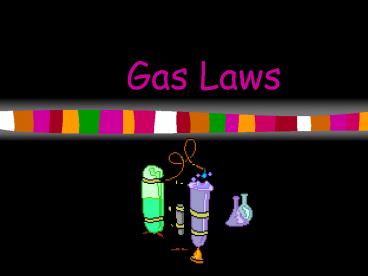Gas Laws PowerPoint PPT Presentation
1 / 22
Title: Gas Laws
1
Gas Laws
2
Molecules In The Air
- How do we know there are molecules in the air?
- Has anyone ever had wind burn?
- How about smelled a hamburger when you drove by
McDonalds? - These examples demonstrate that air is made up of
constantly moving molecules.
3
Kinetic Molecular Theory
- Kinetic energy is perfectly maintained in
elastic molecular collisions. - Molecules are in constant Motion.
- Vibrational motion.
- Translational motion.
- Tiny particles called molecules make up all
matter.
4
Kinetic Molecular Theory
- Describes only Ideal Gases
- Ideal gases follow the gas laws in all conditions
of pressure and temperature. - Ideal gases assume particles of gas have no
volume or intermolecular attraction. - Ideal gases have perfectly elastic molecular
collisions.
5
In REALITY!
- Real gases have volume.
- Real gases have some intermolecular attraction.
- Real gases can be liquefied and solidified by
cooling and applying pressure.
- In reality, experimentation shows us that real
gases do not follow Ideal Behavior
6
Gases Are All Around Us!
- Many gases are invisible, but some we can see.
- Iodine Vapor is Pink.
- Chlorine Gas is Yellow-Green.
- Smoke, clouds, and fog are NOT gases!!
7
Gases Are All Around Us!
- Some gases we can smell.
- Hydrogen Sulfide smells like rotten eggs.
- In natural gas, a smell has been added for our
protection. - Other gases we cant smell at all.
8
Gases Are All Around Us!
- Gases have mass.
- Balloons that are filled with air weigh more than
those that are un-filled.
- When air moves it can do work. For example
tornadoes or windmills.
9
Gases Are All Around Us!
- Gases occupy space, or have volume.
- Examples
- Inflated Balloon
- Our Lungs
- Scuba Tanks
10
Gas Behaviors
- Compressibility
- The volume of a gas can be decreased by
increasing the pressure. - Permeability
- The mixing of molecules in a container.
- Diffusion
- The ability to spread from a high concentration
to a lower concentration. - Expansibility
- The ability of a gas to expand and fill a
container of any size.
11
Under Pressure
- What causes pressure?
- Pressure is caused by the collision of gas
molecules. - The molecules can collide with each other or with
the walls of their container.
12
Atmospheric Pressure
- Air exerts pressure on earth.
- Gravity holds air molecules in the earths
atmosphere. - Atmospheric Pressure occurs when those air
molecules collide with each other or other
objects. - Atmospheric pressure decreases as you move to a
higher elevation.
13
Gas Laws
- There are several different gas law equations.
- Variables
- V
- P
- T
- n
- R
- d
- ?
14
Variables
- V volume in liters.
- T temp in Kelvins.
- P pressure in atm, mmHg, or kPa.
- n number of moles of gas.
- R the universal gas constant.
- d gas density in g/L.
- ? molar mass of a gas in g/mol.
15
Units of Pressure
- Pressure is defined as a force over a specific
area. - PF/A
- English system
- lbs/in2 PSI
- Metric system
- N/M2Pascal
16
Boyles Law
- Robert Boyle (1627-1691)
- At a constant temperature, volume and pressure of
a gas are inversely proportional.
17
Boyles Law
- As pressure increases, volume decreases, and vice
versa. - V1P1V2P2
- V œ 1/P
- Remember the volume of a gas can NOT be squeezed
down to zero!
18
Charless Law
- Jacques Charles (1746-1823)
- At constant pressure, the volume of a gas and
temperature are directly proportional.
19
Charless Law
- As temperature increases, volume increase, and
vice versa. - V1/T1V2/T2
- V œ T
- Gases expand as they get warm , and contract as
they cool.
20
Gay-Lussacs Law
- Joseph Gay-Lussac (1778-1850)
- At constant volume, gas temperature and pressure
are directly proportional.
21
Gay-Lussacs Law
- As temperature increases, pressure increases, and
vice versa. - P1/T1P2/T2
- T œ P
- This is why aerosol cans say Do not incinerate!
22
Combined Gas
- To simplify life, Boyles Law, Charless Law and
Gay-Lussacs Law have been put together into one
mathematical expression. - Combined Gas Law
- V1P1 V2 P2
- T1 T2

